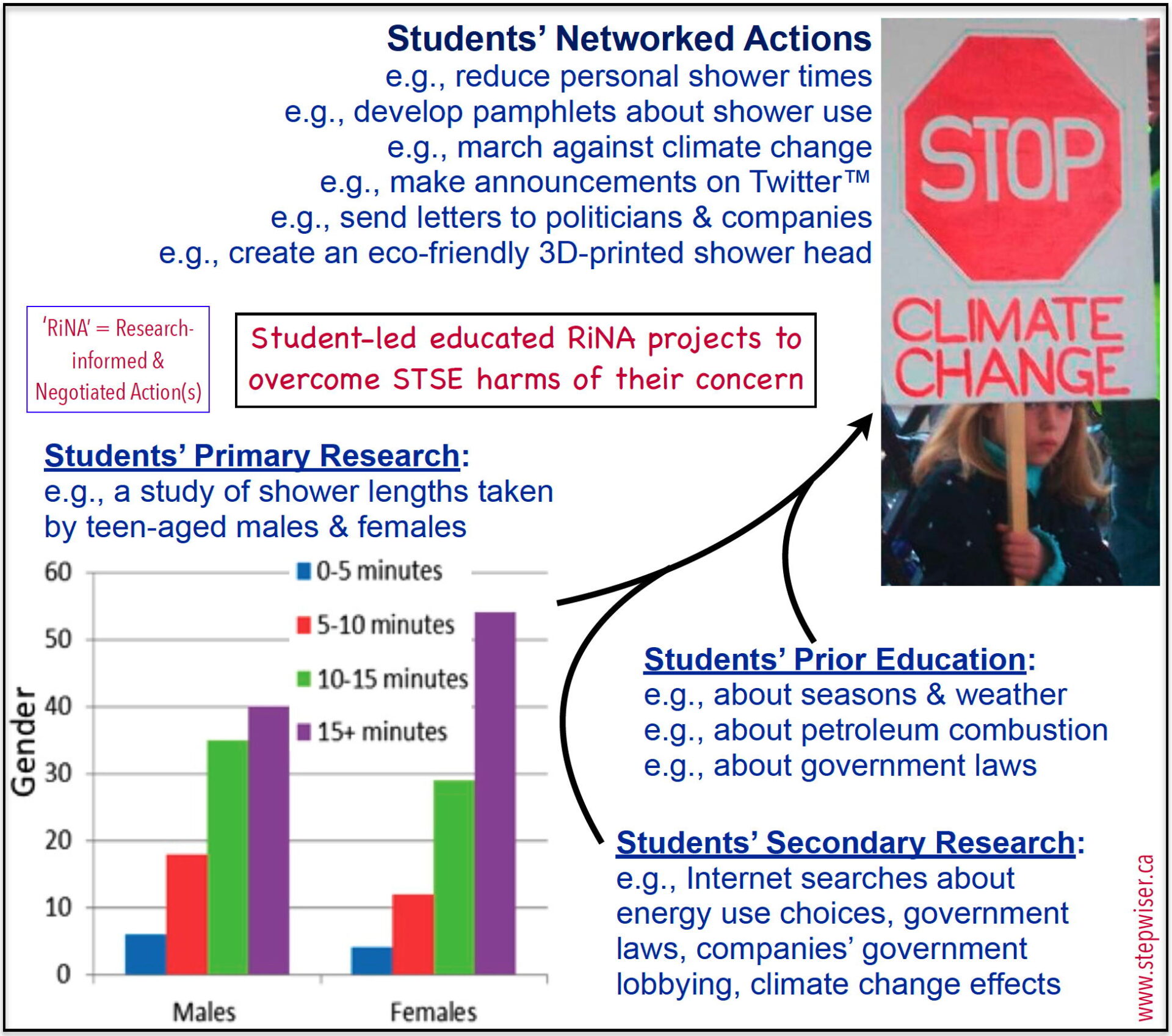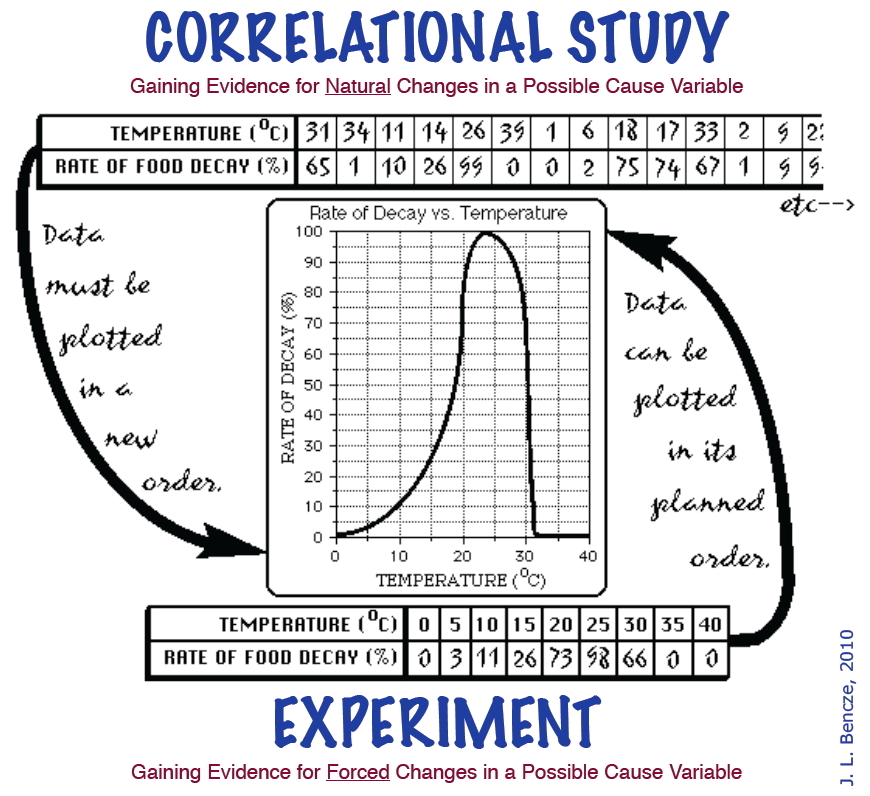Skills for Science Inquiry, Technology Design, Related Communications & Actions
This page provides information, pedagogical suggestions & resources for helping students develop expertise, confidence & motivation for eventually self–directing science inquiries (e.g., experiments &/or studies), engineering design projects, related communications & personal & sociopolitical actions.
Skills for RiNA Projects
Students likely need ‘skills’ (e.g., expertise, confidence & motivation) for numerous purposes. But, given extents of STEM-SE harms, STEPWISE prioritizes skill development like those illustrated at right/below for students’ eventual self-led RiNA projects to overcome ST[EM]SE harms of their concern. For citizen autonomy, STEPWISE prioritizes helping students to increasingly gain control over procedures and conclusions (see Lock, 1990, model) of their activities. Such self-led knowledge generation & actions can be compromized when teachers and/or textbooks provide extensive guidance – something that seems prevalent where there is intense pressure to orient science/STEM education towards selection & education of potential knowledge producers like engineers, scientists, etc. To help promote citizen autonomy, as with all learning outcomes, we recommend uses of our 3-phase, constructivism-informed, schema for such skill development. Resources below are based on STEPWISE, but have largely been informed by my old Skills Apprenticeship Handbook – which I suggest needs to be updated to promote skills learning in STEM-SE contexts.
Many science education research studies suggest that many educators and others hold relatively ‘rationalist’ (logical & empirical) conceptions of the nature of science & engineering (S&E) – such as that depicted at right/below. STS (Science & Technology Studies) scholars, who study work of STEM professionals and more, suggest, however, that depictions like that at right/below are mythical and that, for example, they often are nonlinear and, perhaps, most importantly, often biased in some problematic ways. Nevertheless, in the spirit of constructivist learning theories and others, it can be helpful to start with the model at right/below – while reminding students that it is stereotypical and needs testing.
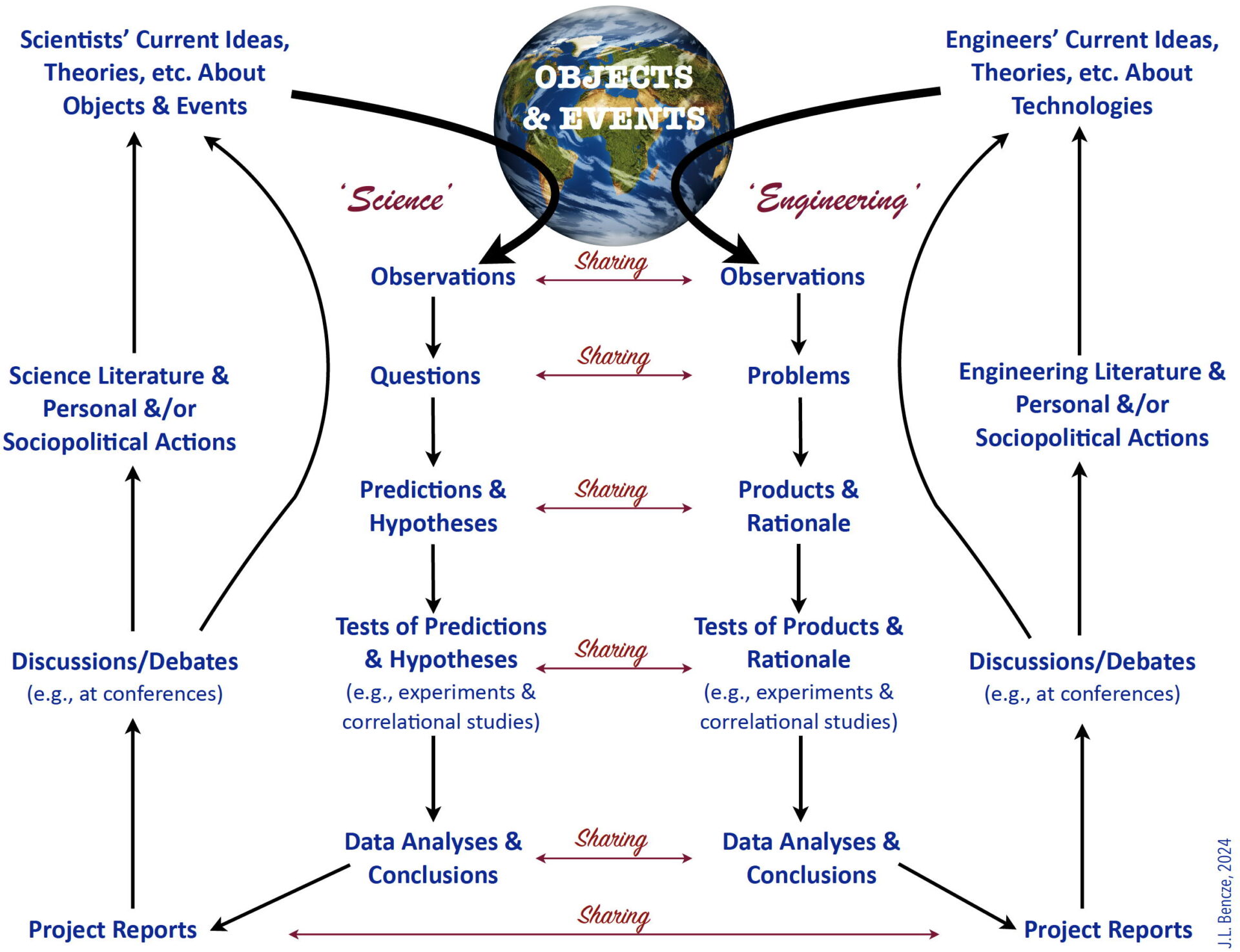
‘Science’ vs. ‘Technology’/Engineering
Science and engineering may be thought of as different fields. As indicated at right/below, for example, many believe that their goals differ – with scientists aiming to document & explain existing ’cause’ (C) –> result’ (R) relationships, while engineers (& technologists) seek to invent new C–>R relationships. Roth (2001) suggested, however, that – as illustrated below (and elaborated here) – ‘science’ & ‘technology’ in STEM co-affect each other and, so, perhaps have much in common or may be considered hybrid.

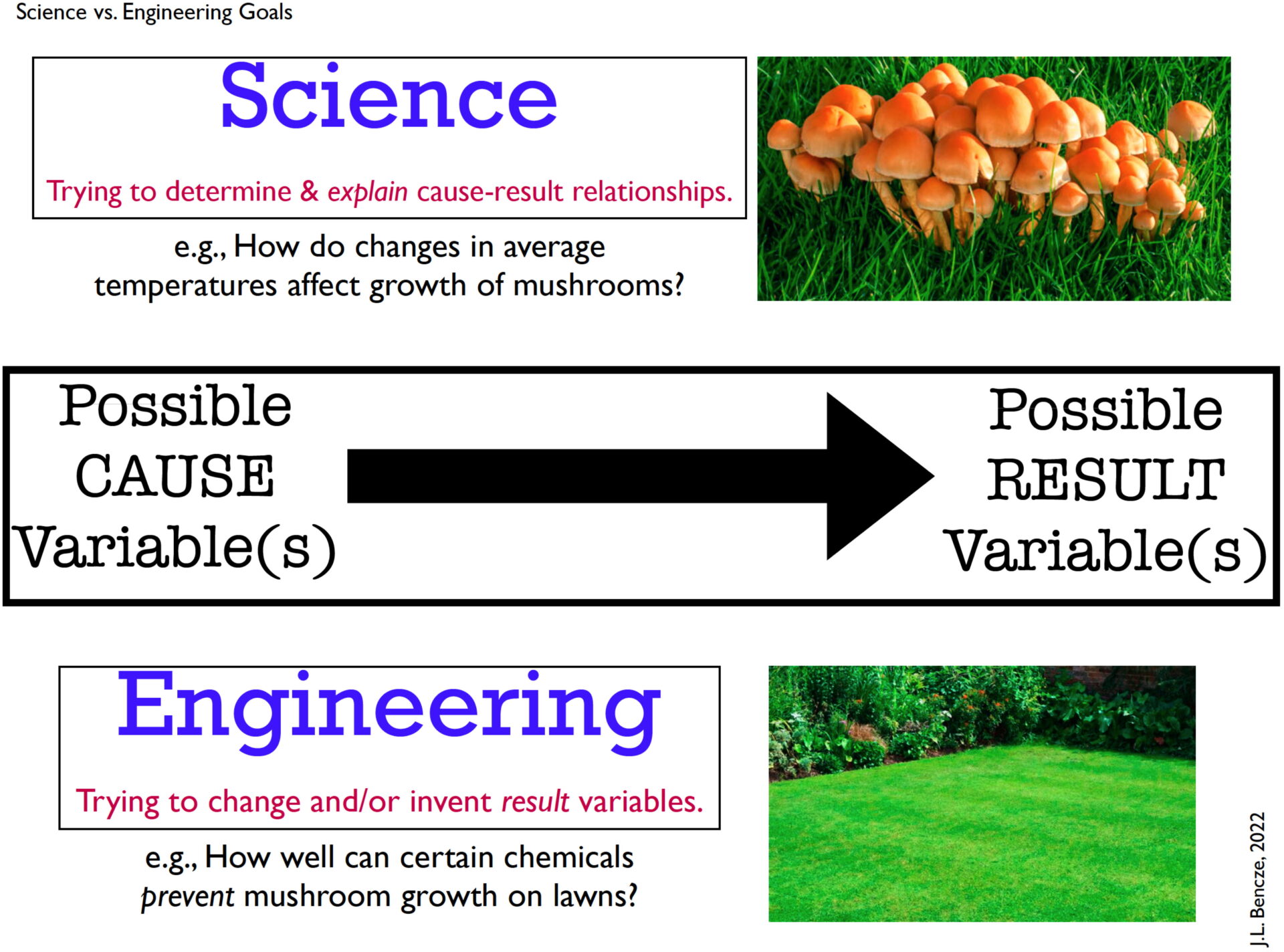
Choosing Variable Combinations to Research
For science inquiries and for technology/engineering design projects, it is common for investigators to explore – as illustrated at right/below – possible influences of changes in one or more independent (’cause’) variables on one or more dependent (‘result’) variables and, perhaps eventually, provide a possible explanation (‘hypothesis’) of why two or more of the variable sets are related in certain ways. Among ways to choose such variable combinations, people can propose relationships between lists of variables given here. They might suggest decreased sleep time will reduce human memory and hypothesize that this may be due to build-up of toxins in the brain. Similarly, in engineering design, they may suggest that decreases in wing density (e.g., with added air pockets) should increase airplane fuel economy because of increased wing lift.
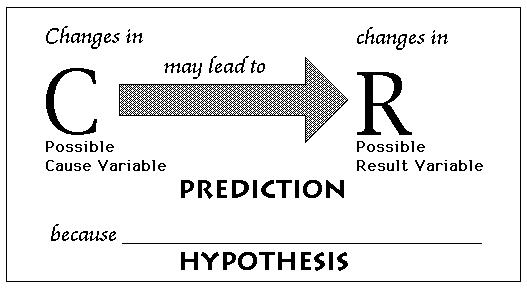
e.g., Increased atmospheric CO2 may rapidly increase average global temperatures, because CO2 traps heat from being released into space through the atmosphere.
Skills for Science Inquiries
With reference to the above stereotypical model of skills & processes of science & technology, predictions & hypotheses can be tested empirically either with experiments or correlational studies. As shown at right/below, experiments involve monitoring results of ‘forced’ changes in ’cause’ (independent) variables while studies involve inquiries into possible causal correlations between naturally-changing independent and dependent variables. As well, changed amounts of the independent variable in experiments usually have regular intervals (e.g., 0, 5, 10oC, etc.), but those in studies are typically collected in irregular intervals (and, so, must be added to graphs rearranged to have regular intervals for the independent variable). Choices between the two processes often depend – as elaborated here – on practicalities & ethics. In inquiries into STSE Harms that may occur in RiNA projects, although investigators may use experiments, they may most-ethically choose correlational studies if experimentation would generate harmful results (e.g., a study of increased cigarette smoking as may affect amounts of finger discolouration).
When the teacher feels it is necessary (after students have been given a RiNA project assignment), the teacher can use suggestions & resources in the videos at right/below to help students to develop expertise, confidence & motivation for designing & conducting correlational studies and social actions and RiNA projects, overall. Skills Apprenticeship resources, here, also may help – although like this example, they likely need to be revised (from 2010) to use STSE contexts for skills education.
Resources: STSE Issues List; Sample RiNA Project Assignment Sheet.
Skills for Engineering Designs
As indicated in the above stereotypical model of processes of science & technology, technological invention (with reasons for designs) may be comparable to predictions about changes in dependent variables that may result from changes in independent variables in science inquiries. In science inquiries, investigators often attempt to ‘control’ (keep unchanged) all independent variables except one; but, in technological design, engineers often change several independent variables at once – to, in a sense, determine a ‘recipe’ of several variable changes that may give rise to optimal sets of results. As shown at right/below, for instance, making a suitable tent may require a balance of uses of certain chemicals, fibre weaving & materials. Such designs are complex because changes in some independent variables can positively affect changes in some dependent variables, but negatively affect others. Such compromises can be problematic; e.g., when waterproofing is more valued than chemical toxicity. Additional theory about engineering design education is available here.
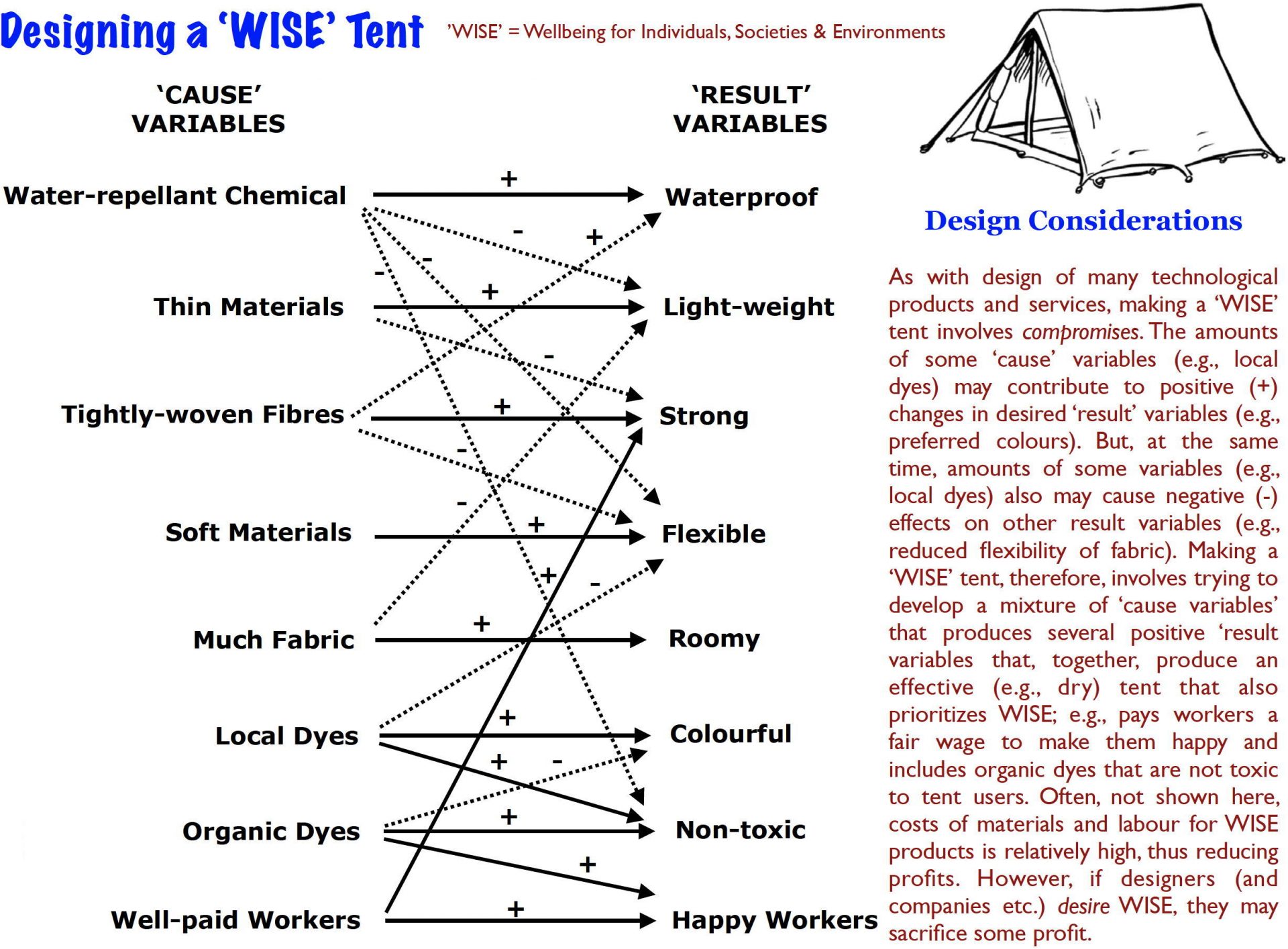
Skills for Communications & Actions
As the teen climate campaigner, Greta Thunberg, says in the video at right/below, because governments have tended not to adequately address many STSE Harms, apparently because they often prioritize interests of capitalists and other elite over those of general populations, it seems essential that community members research and critically analyze STSE relationships and develop & take altruistic actions (e.g., like these) to overcome harms they identify.
Research-informed & Negotiated Actions
People and groups sometimes make action decisions perhaps largely based on pycho-social factors, as suggested in this hoax. It may seem obvious to say, but choices about actions should seriously consider valid & reliable research – and on social negotiations to help minimize personal biases. The STEPWISE project has, accordingly, been promoting such ‘RiNA’ projects. Civic actors should, nevertheless, exercise ‘prudence’ (e.g., skepticism) about research & social negotiations – remembering, for instance, that much secondary (e.g., Merchants of Doubt) & primary (e.g., Corrupted Science) research may be biased. The video at right/below depicts one student-led RiNA project that may have biases.
Although ‘singular’ student actions, like slideshows for a class, posters or ecojust engineering products, may be very positive, they may not generate much large-scale change. As indicated in this video, it seems clear we live in networked societies. Indeed, based on actor-network theory, Gaia Theory and others, it appears we all are embedded in a global (at least) network of (natural & human-made) living, non-living & symbolic (semiotic) actants. Power/influences across such networks, moreover, appear to be concentrated – able to form dispositifs; that is, assemblages of actants mainly worked towards common goals – such as prioritizing leadership. Much such power is, apparently, held by capitalists who – in neoliberal forms – assembled diverse actants like governments, technologies, scientists, educators, and mind-sets of citizens into pro-capitalist dispositifs that have concentrated wealth at expense of myriad & severe STSE Harms.
Given, as described at left/above, problematic effects of networked power relations, it seems imperative that civic actions be multi-pronged – as promoted in the above video – to spread ecojustice values across myriad (a)biotic actants.
